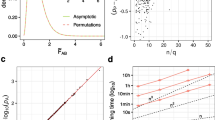Abstract
Kruglyak and Lander (1995) recently published a multipoint sib-pair procedure based on the expected distribution of zero, one and two marker alleles shared identical by descent (ibd) and the method of maximum-likelihood (ML). Their approach uses phenotypic sib-pair differences, which ignores the bivariate structure of sib-pair data. Their simulations suggested that their method was more powerful than the regression method of Haseman and Elston (1972). We show through computation and simulation that their approach can be made more powerful still if the bivariate nature of sib-pair data is acknowledged. In addition, methods based on the average number of shared alleles that also employ bivariate ML procedures (Nance and Neale, 1989; Xu and Atchley, 1995) are more powerful than the approach they recommend and very similar to true ML using the distribution of ibd. The simple ML approach using the average number of shared alleles that we recommend seems to offer both optimal power and flexibility.
Similar content being viewed by others
References
Eaves, L., and Meyer, J. (1994). Locating human quantitative trait loci: Guidelines for the selection of sibling pairs for genotyping.Behav. Genet. 24:443–455.
Fulker, D. W., Cherny, S. S., and Cardon, L. R. (1995). Multipoint interval mapping of quantitative trait loci, using sib pairs.Am. J. Hum. Genet. 56:1124–1233.
Haseman, J. K., and Elston, R. C. (1972). The investigation of linkage between a quantitative trait and a marker locus.Behav. Genet. 2:3–19.
Kruglyak, L., and Lander, E. S. (1995). Complete multipoint sib-pair analysis of qualitative and quantitative traints.Am. J. Hum. Genet. 57:439–454.
Nance, W. E., and Neale, M. C. (1989). Partitioned twin analysis: A power study.Behav. Genet. 19:143–150.
Neale, M. C., and Cardon, L. R. (1992).Methodology for Genetic Studies of Twins and Families, NATO ASI Series, Kluwer Academic Press, Dordrecht, The Netherlands.
Numberical Algorithms Group (1988).The NAG Fortran Library Manual. Mark 13, NAG, Oxford.
Xu, S., and Atchley, W. R. (1995). A random model approach to interval mapping of quantitative trait loci.Genitics 141: 1189–1197.
Author information
Authors and Affiliations
Corresponding author
Rights and permissions
About this article
Cite this article
Fulker, D.W., Cherny, S.S. An improved multipoint sib-pair analysis of quantitative traits. Behav Genet 26, 527–532 (1996). https://doi.org/10.1007/BF02359758
Received:
Accepted:
Issue Date:
DOI: https://doi.org/10.1007/BF02359758




